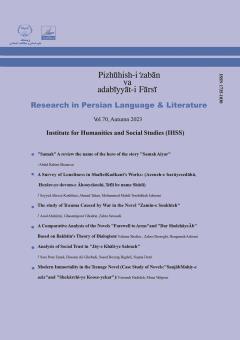Style is a writer’s or a poet’s specific way of expressing their intended concepts in literary works. Style has been defined in various ways. Today, it refers to the methods that are used to analytical study of literature by using linguistic devices. It also studies the
More
Style is a writer’s or a poet’s specific way of expressing their intended concepts in literary works. Style has been defined in various ways. Today, it refers to the methods that are used to analytical study of literature by using linguistic devices. It also studies the point of view, linguistic features, the ways of characterization and formation of the theme. The main characteristics of Mahmoud Dowlatabadi’s works, especially his novel ‘Jay-e Khali-ye Solouch’ is giving importance to the language, and the poetic structure of the text. For instance, employing the region & ethnic-specific words and expressions in this novel reveals the main feature of his archaic language adapted from the works such as Tarikh-e Beihaqi.
The authors of the present article attempt to explore the stylistic features of the novel ‘Jay-e Khali-ye Solouch’, studying its linguistic and poetic structures, including lexemes, imagery, variations among the sentences, rhythm, repetition, cohesion, emphasis, and so on.
Manuscript profile


